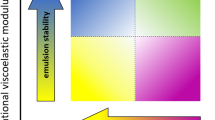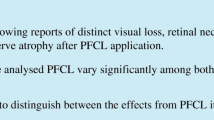Abstract.
Background: Partially fluorinated alkanes (FALKs) are a new class of substances which can be used in vitreoretinal surgery as an intraoperative tool and as a long-term tamponade. The aim of this in vitro study was (1) to investigate the solubility of FALKs in silicone oil during direct exchange, (2) to study their combined use and solubility in PFCLs, (3) to evaluate their lipophilic properties and (4) to investigate the possibility of preparing "heavy silicone oil". Methods: (1) Four different FALKs (F6H6, F6H8, O44 and O62) were directly exchanged with silicone oil (5,000 mPas). The dissolved amount of fluorocarbons in the removed silicone oil was determined by gas chromatography and by gravimetry. Furthermore, the diffusion phenomena during the exchange process were studied. (2) The behaviour of FALKs in PFCLs was investigated and the solubility of the resulting mixtures in silicone oil was measured. (3) The solubility of FALKs and PFCLs in native olive oil was analysed. (4) Different FALKs were added to silicone oil and measurements of the resulting specific gravity and the viscosity were performed. Results: (1) FALKs dissolved in silicone oil up to the following values: F6H6=45 m%, F6H8=54 m%, O44=100 m%, O62=18 m%. (2) FALKs dissolved in PFCL, thereby changing the physicochemical properties of PFCL depending on the type of FALK and ratio used. (3) The lipophilic properties of FALKs and PFCLs could be characterized by their dissolution in native olive oil (F6H8=23.4 m%, O44=16.7 m%, F6H6=12.3 m%, O62=5.3 m%, PFD=1.1 m%, PFO=0.6 m%). (4) It was possible to prepare "heavy silicone oil" e.g. by adding 30 vol% F6H8, resulting in a specific gravity of 1.08 g/ml, or by adding 80 vol% O44, resulting in a specific gravity of 1.25 g/ml, but decreasing the viscosity of the mixtures dramatically. Conclusion: (1) If FALKs are used as an intraoperative tool, a direct exchange with silicone oil should be avoided owing to their capacity to dissolve in silicone oil, resulting in a mixture with unpredictable properties. (2) A combined use with PFCLs and silicone oil is possible, if the right ratio is chosen. (3) The solubility of FALKs in native olive oil may be an indicator for their tissue penetration and may render feasible their use as a long-term tamponade. (3) "Heavy silicone oil" preparation using FALKs is possible, but the mixture needs further evaluation in terms of emulsification, mobilization of oligosiloxanes, tissue penetration and long-term stability.
Similar content being viewed by others
Author information
Authors and Affiliations
Additional information
Electronic Publication
Rights and permissions
About this article
Cite this article
Hoerauf, H., Kobuch, K., Dresp, J. et al. Combined use of partially fluorinated alkanes, perfluorocarbon liquids and silicone oil: an experimental study. Graefe's Arch Clin Exp Ophthalmol 239, 373–381 (2001). https://doi.org/10.1007/s004170100264
Received:
Revised:
Accepted:
Issue Date:
DOI: https://doi.org/10.1007/s004170100264




